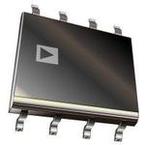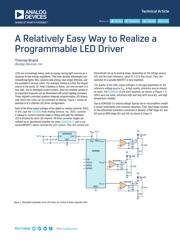Datasheet 搜索 > 运算放大器 > ADI(亚德诺) > ADA4500-2ARMZ-R7 数据手册 > ADA4500-2ARMZ-R7 用户编程技术手册 2/2 页

 器件3D模型
器件3D模型¥ 19.11
ADA4500-2ARMZ-R7 用户编程技术手册 - ADI(亚德诺)
制造商:
ADI(亚德诺)
分类:
运算放大器
封装:
MSOP-8
描述:
10兆赫, 14.5纳伏/ A ????赫兹,轨至轨I / O,零输入交越失真放大器 10 MHz, 14.5 nV/âHz, Rail-to-Rail I/O, Zero Input Crossover Distortion Amplifier
Pictures:
3D模型
符号图
焊盘图
引脚图
产品图
ADA4500-2ARMZ-R7数据手册
Page:
of 2 Go
若手册格式错乱,请下载阅览PDF原文件

2
A Relatively Easy Way to Realize a Programmable LED Driver
Analog Devices, Inc.
Worldwide Headquarters
Analog Devices, Inc.
One Technology Way
P.O. Box 9106
Norwood, MA 02062-9106
U.S.A.
Tel: 781.329.4700
(800.262.5643, U.S.A. only)
Fax: 781.461.3113
Analog Devices, Inc.
Europe Headquarters
Analog Devices GmbH
Otl-Aicher-Str. 60-64
80807 München
Germany
Tel: 49.89.76903.0
Fax: 49.89.76903.157
Analog Devices, Inc.
Japan Headquarters
Analog Devices, KK
New Pier Takeshiba
South Tower Building
1-16-1 Kaigan, Minato-ku,
Tokyo, 105-6891
Japan
Tel: 813.5402.8200
Fax: 813.5402.1064
Analog Devices, Inc.
Asia Pacific Headquarters
Analog Devices
5F, Sandhill Plaza
2290 Zuchongzhi Road
Zhangjiang Hi-Tech Park
Pudong New District
Shanghai, China 201203
Tel: 86.21.2320.8000
Fax: 86.21.2320.8222
©2019 Analog Devices, Inc. All rights reserved. Trademarks and
registered trademarks are the property of their respective owners.
Ahead of What’s Possible is a trademark of Analog Devices.
TA21302-4/19
analog.com
I2
I1
+V
S
–V
S
–IN
OUT
+IN
Q1 Q2Q3 Q4
Figure 2. Simplified rail-to-rail bipolar transistor input stage on the operational
amplifier.
Depending on the applied common-mode voltage, the two input pairs
yield different offset voltages and bias currents. If a common-mode voltage
is applied to the amplifier input that differs by less than 0.7 V from the
negative or positive supply voltage
(
V
S
)
, only one of the two input stages
will be active. Then only the error
(
offset voltage and bias current
)
of the
respectively active stage will appear. If the voltage rises to 0.8 V, both
input stages will be active. In this case the offset voltage can change
abruptly, leading to so-called crossover distortion and nonlinearity.
In contrast, the ADA4500-2 has an integrated input-side charge pump,
which makes it possible to cover the rail-to-rail input range without
a second differential pair and thus avoid crossover distortion. Other
advantages of the ADA4500-2 are its low offset, bias current, and noise
components.
In such circuits, it is important that attention be paid to inductance in the
load/current path, which can arise through the wiring of the LEDs. The
wires are often several meters long and could cause undesired oscilla-
tions if correct compensation is not provided. The compensation in this
circuit is achieved by a feedback path that returns the current, measured
by a shunt resistor, to the input of the op amp. The existing resistor and
capacitor circuitry on the ADA4500-2 should be adjusted according to
the arising inductance.
With the circuit shown in Figure 1, a multichannel LED driver that can be
programmed via a DAC for precise lighting control applications can be real-
ized relatively easily. However, it is important to adapt the dimensioning
to the specific requirements to avoid malfunctioning.
Conclusion
The circuit described in this article shows a relatively easy way to create
a programmable LED driver that is ideal for precise lighting control
applications that require a compact, scalable, easy to power, and highly
linear power source. However, the dimensions must be adapted to the
requirements of the application in order to avoid any malfunction due to
the various present inductivities, such as line and parasitic inductivity.
About the Author
Thomas Brand began his career at Analog Devices in Munich in
October 2015 as part of his master’s thesis. From May 2016 to
January 2017, he was part of a trainee program for field applica-
tion engineers at Analog Devices. Afterward, in February 2017,
he moved into the role as a field applications engineer. Within
this role, he is mainly responsible for large industrial customers.
Furthermore, he specializes in the subject area of industrial
Ethernet and supports appropriate matters in central Europe.
He studied electrical engineering at the University of Cooperative
Education in Mosbach before completing his postgraduate studies
in international sales with a master’s degree at the University
of Applied Sciences in Constance. He can be reached at
thomas.brand.email@analog.com.
Online Support
Community
Engage with the
Analog Devices technology experts in our online support
community. Ask your tough design questions, browse FAQs,
or join a conversation.
Visit ez.analog.com
器件 Datasheet 文档搜索
AiEMA 数据库涵盖高达 72,405,303 个元件的数据手册,每天更新 5,000 多个 PDF 文件


